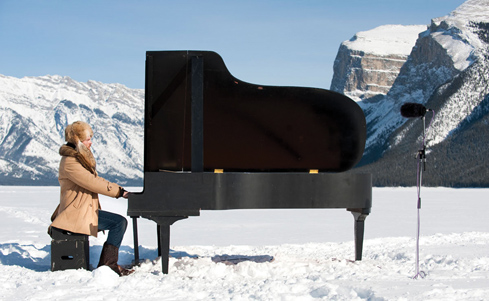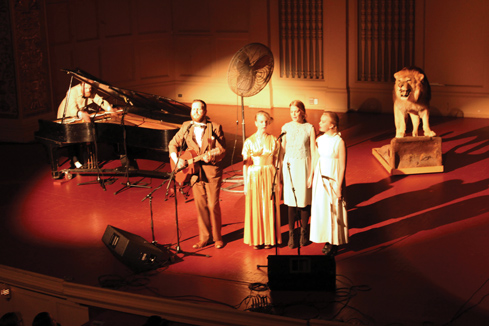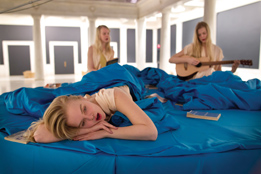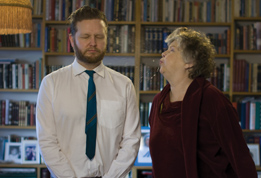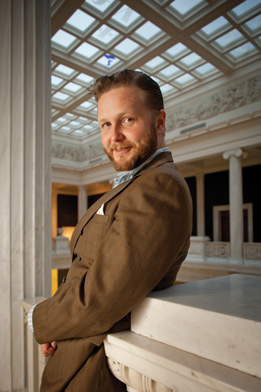 |
||||||||
|
Ragnar Kjartansson, The Man, 2010, Courtesy of the artist, Luhring Augustine, New York, and i8, Reykjavík
|
The Ragnar Kjartansson Experience
He came to Carnegie Museum of Art for his first-ever solo exhibition at an American museum. What he left behind is a museum, and a city, that became part of his art. Ragnar Kjartansson doesn’t necessarily look the part of the eccentric Icelander. With pomaded hair and ruddy beard, casual suit and bowtie, he appears more like an extra in a Bing Crosby flick than a Viking warrior. But nor does he do much to dispel the stereotype. A former rocker with the tongue-in-cheek band Trabant, Kjartansson has become the shooting star of the European art world for his off- kilter, long-duration performance works and the sublime, humorous videos that document them. Kjartansson was unofficially passed the torch at the 2010 Venice Biennale, where his video installation and months-long performance work The End garnered unparalleled critical praise. It was there that Carnegie Museum of Art associate curator of contemporary art Dan Byers met him and began planning Ragnar Kjartansson: Song, the artist’s first solo American museum exhibition, on view at the Museum of Art through October 9. Like most of Kjartansson’s artwork, the end product of Song isn’t the performance or even the video. His true art: the moments those pieces necessitate—the collaborations he elicits, the stories that come after the performance, the world that’s created along the way.
Ragnar Kjartansson, The End, 2008, Courtesy of the artist, Luhring Augustine, New York, and i8, Reykjavík“I had a conversation with [legendary performance artist] Marina Abramovic´and she said, ‘When I do my performance, it’s like going on vacation,’” Kjartansson says. “My performances are like role-playing. I get to inhabit some other world.” This past March, that alternate world existed in and around Carnegie Museum of Art. Its inhabitants included Kjartansson; his wife, the performance artist Ásdís Sif Gunnarsdóttir; their seven-month-old daughter, Solveig; assorted nieces and friends from Iceland; and, just as important, artists, musicians, and many new friends from Pittsburgh. “I meet people, we become friends, and then I always end up collaborating with them,” says Kjartansson. “When you’re a grown-up, it’s a good excuse to hang out! These pieces come from a need to be loved, for sure. But it’s a need to be loved turned into a finely tuned act.” The in-between momentsAfter experiencing Kjartansson’s live Song installation, it’s difficult to walk through Carnegie Museum of Art’s Hall of Sculpture without hearing voices: the faint, three-part harmony, “The weight of the world/is love.” For three weeks this past spring, those voices had an enchantingly beautiful source—Kjartnasson’s three nieces, Rakel, Harpa, and Iris Leifsdóttir, draped over pillows on a royal-blue plinth, lazily plucking a guitar and reading poetry as they sang their uncle’s brief composition again and again. Like most of Kjartansson’s work, this long-duration performance piece, titled simply Song, is a collaboration. Working with the nieces, the costume and set designers, and sound experts, the artist became more director than actor. More importantly, Song took on the characteristics of its most important collaborator: its audience.
Ragnar Kjartansson in his natural element: on stage. His month-long residency culminated with the musical event .
“There was a storm one day,” recounts Rakel. “There was one boy in the room at the time—he was about 20, alone, just listening. And suddenly these black clouds came [over the skylights] quickly, and all the light went out. There was lightning, and hail, and this boy sat down and he just started crying.” “He had this amazing moment,” says Harpa, the oldest of the three sisters. “People bring their own energy to the piece, so when a child starts dancing, or a woman points and whispers, it changes our performance. And that’s the real collaboration in Ragnar’s work, between the performers and the audience. Because there’s no direct interaction, but there’s always collaboration.” Pittsburgh artist Mike Cuccaro was one of those collaborators. On the final day of the sisters’ performance, Cuccaro brought his sketchpad to the museum and began a series of three paintings inspired by Song.
Kjartansson’s art revolves around those in-between moments in which consciousness and the unconscious, seriousness and the absurd, performance and reality, all become inseparable things. It’s a theme he first explored in the three-video series Me and My Mother, made in 2000, 2005, and 2010, respectively, and displayed side by side in the Museum of Art lobby as part of Ragnar Kjartansson: Song. In each video, the artist stands dutifully beside his mother as she turns and spits on him. It’s absurd, funny, and a little bit bad. According to Byers, it’s also the key to Kjartansson’s work. “It provides that behind-the-scenes look, and establishes Ragnar as a performance artist and his mother as the grand diva,” says Byers. “It’s the lynchpin to the show: you see him aging, you see the way he chooses to present himself change. It’s a little lexicon as to how he makes his choices.” “This piece made me realize what I was doing in my art,” says Kjartansson. “It’s about this friction between pretending and doing; that point where it’s close to reality, but it’s acted, yet not really acted.
Natural storytellerKjartansson comes by his balance of serious artist and theater ham honestly. He was born into the theater, his father a lauded playwright and director (confusingly known as Kjartan Ragnarsson, thanks to Iceland’s traditional naming system). Ragnar’s mother is a highly regarded star of stage and screen, Gudrun Asmundsdóttir. But while he learned the theater from his parents, his lessons in performance came from a more profound place. “My godmother was an old singer,” says Kjartansson. “She was very European, refined. She lived in our basement and started giving me sherry when I was 12! And she was very much a performer.” In 1930s Germany, Kjartansson’s godmother established a reputation singing Icelandic folk songs alongside Yiddish songs. “Half her program became a big hit with the Nazis,” says Kjartansson, “the other half, not so much. So she told me all about performance, how she coped with that situation. ‘I just sang the Icelandic songs, and I could see those silly men in their uniforms having a good time, so I’d just change to Yiddish songs—they were having so much fun, they forgot they were Nazis!’ “It taught me what performing really was—it was a game; it’s not just about being liked, it’s about survival.” That notion of surviving through living art seems to be a way of life in Icelandic culture. Kjartansson notes that there is no history of visual culture there—no tradition of artistic or cultural objects one might own. In Iceland, it was always the stories—the sagas that told of the Norsemen coming to the island, and the poems and plays that told of what they did. “A 1,000-year-old culture, and no proof that it existed except these stories,” says Kjartansson. “You drive through the landscape, and every hill, every farm, has a story connected to it. That’s how my performance works are. I don’t believe in the idea that you have to obtain the art piece to have it—or even see the art piece. It exists as a story.”
As part of Ragnar Kjartansson and Friends, a vaudeville-style show in The Warhol’s Off the Wall lineup, featuring the artist and assorted family and friends from Iceland, Kjartansson debuted the musical performance Piece for Eight Guitars. Created with Icelandic composer Kjartan Sveinsson (of art-rock band Sigur Rós), the work called for eight Pittsburgh acoustic guitarists (“eight troubadours,” Kjartansson called them) to play interwoven ethereal chord progressions in the Carnegie Music Hall Foyer—before, after, and during the show happening inside the theater. Pittsburgh-based filmmaker Ben Hernstrom, who visited Iceland for two months as part of an artist’s residency, documented the performance. To him, Kjartansson’s work is entirely about the collaborative process—a trait indicative of the isolated Icelanders’ reliance on interaction and creativity to simply survive. “There’s a warmth, and an artistic sense of wonder in him,” says Hernstrom. “It breeds this kind of sharing. There was never the idea that ‘I have a perspective, and I need to tell you it.’ It was very much, ‘these are the things I’d like this to do, let’s find a way to do it together.’ “Part of that’s just his work in general—it’s about interacting, about shared experience. But there’s a very social quality to the entire culture, and as one woman in Iceland told me, ‘If we didn’t care about each other, we’d all be dead.’” Collaborative cultureStanding in the middle of Carnegie Museum of Art’s Forum Gallery, Kjartansson’s five-channel video work, The End, surrounds you with floor-to-ceiling video screens on every wall. Each screen features a different shot of the artist and his longtime friend and collaborator, multi-instrumentalist Davíð Þór Jónsson, standing before the imposing landscape of the Canadian Rockies. And in each video, the pair plays one part of a roots-rock song—the guitars, the piano, the drums—with audio recorded live. The result is sublime and defiant, a testament both to the power of collaborative creativity and to its utter impotence in the face of unassailable nature. Although to Kjartansson, it’s much simpler. “When I’m doing a work, I always feel like, ‘Hey, I’m going to rip off this, and rip off this, and maybe that’ll be interesting,’” he says. “For The End, I remembered a video of [’70s roots-rock icons] The Band playing in a cabin in the woods, and mixed that with [composer Karlheinz] Stockhausen’s idea of spatial music —five-dimensional music—but made it all look like a Caspar David Friedrich painting. "People bring their own energy to the piece, so when a child starts dancing, or a woman points and whispers, it changes our performance. And that’s the real collaboration in Ragnar’s work. "
- Harpa Leifsdóttir“And just like The End was with the Rocky Mountains, Song is a location piece,” says Kjartansson. “This Hall of Sculpture—it’s so grandiose, but it’s also Carnegie—it’s America. If it were a palazzo in Italy, it would’ve been cliché. But this is an American tycoon’s fake-European grandeur!” Hauling a grand piano, drum kit, and studio’s worth of recording equipment into the Rockies—much less actually recording in the snow-covered landscape—required Kjartansson and his cohorts to stretch beyond what they thought they were capable of. While the creation of Ragnar Kjartansson: Song included no sled-borne pianos, it pushed the artist’s collaborators into new territory. One of those collaborators was Carnegie Museum of Art, which had to stretch in ways a traditional museum isn’t used to—from the structural logistics of the large-scale The End to the nieces’ weeks-long performance residency in Song. “That’s what the museum is meant to do—we’re meant to throw a little bit of culture into the public, to get people to think and act and feel differently,” says Byers. “This work lives in the way it spreads through the oral culture, and we’ve seen that in the way people talk about it. Something’s happening when you overhear the baristas at Starbucks talking about the show, and when I get stopped and asked about it in the grocery store. “And this is, ideally, what everyone should feel after every show of contemporary art opens: that, yeah, the whole city did this.”
|
|||||||
Spacewalker · Pittsburgh Bred · Tracking the Origins of Humans · Special Section: A Tribute to Our Donors · Directors' Note · NewsWorthy · Face Time: John Wetenhall · About Town: Show-stopping Science · Science & Nature: Remembering Brad · Artistic License: Mixed Signals · The Big Picture
 |
Copyright © 2017 CARNEGIE Magazine. All rights reserved. |

